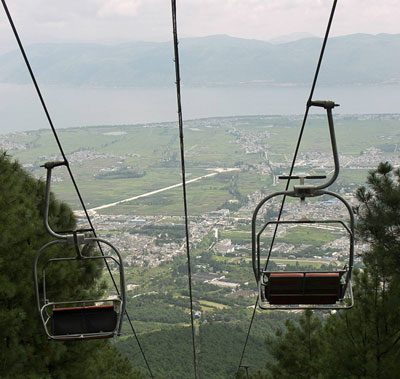Cableways
Cableway Overview
Similar in form to aerial tramways that carry skiers and tourists, a cableway is a means for transporting material to remote locations. Once an oft-used tool for dam and bridge construction, they are now a rarity. A cableway was used to build the New River Gorge Bridge in West Virginia during the 1970s, and a multitude were deployed for constructing the Hoover Dam in the Black Canyon of the Colorado River during the Great Depression. A span of a half-mile and 50-ton lift capacity is attainable.

Cableways Main Parts
A basic cableway is composed of a load-carrying trolley riding on a track cable suspended between two masts. Numerous other cables, static and moving, are needed to make the cableway a practical lifting apparatus. Each mast is stabilized by a forestay, a backstay, and two opposing side guys. The side guys can be live, permitting the masts to luff sideways so that the load on the trolley can be maneuvered laterally. The backstay is usually live on just one mast, called the head lower, allowing the slack in the cable to be adjusted; the opposing tail tower would be stationary. Increasing the catenary sag in the track cable by tilting the head tower forward causes an increase in the load carrying capacity.
The trolley is pulled in either direction by inhaul-outhaullines. A load hoist cable raises and lowers the trolley. Slack carriers are suspended from the track cable to take out the sag from the haul ropes and the load line. A messenger line suspended from the masts carries electrical wires and the like.
Installation and operation of a cableway
Just as with some derrick types, installation and operation of a cableway require specialized skills that are no longer readily found in the labor pool. The cost and time for installing and operating are relatively great. As a result of these drawbacks and the availability of alternatives, cableway applications are limited to a very few circumstances typically involving long-term lift work over a chasm or to a remote location. A helicopter, tower crane, or other work method is likely to prove more practical in nearly all instances.
Relative FAQ

Email: sales@bossbuyer.com
Skype: bossbuyer
Market Hotline
0086-21-61435-919
Service Hotline:
0086-21-61435-919
